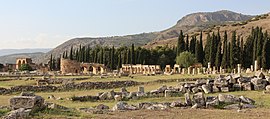Ἱεράπολις | |
 | |
| Alternative name | Hierapolis-Pamukkale |
|---|---|
| Location | Pamukkale, Denizli Province, Turkey |
| Region | Phrygia |
| Coordinates | 37°55′30″N 29°07′33″E / 37.92500°N 29.12583°E |
| Type | Settlement |
| History | |
| Founded | early 2nd century BC |
| Abandoned | 14th century (final occasion) |
| Periods | Roman Republican to High Medieval |
| Site notes | |
| Excavation dates | 1887, 1957–2008 |
| Archaeologists | Carl Humann, Paolo Verzone |
| Official name | Hierapolis-Pamukkale |
| Type | Mixed |
| Criteria | iii, iv, vii |
| Designated | 1988 (12th session) |
| Reference no. | 485 |
| UNESCO Region | Europe and North America |
Hierapolis (/ˌhaɪəˈræpəlɪs/; Ancient Greek: Ἱεράπολις, lit. "Holy City") was a Hellenistic Greek city built on the site of a Phrygian cult center of the Anatolian mother goddess Cybele,[1][2] in Phrygia in southwestern Anatolia. It was famous for its hot springs, its high quality wool fabrics and dyes, and as the birthplace of the Stoic philosopher Epictetus. Its extensive remains are adjacent to modern Pamukkale in Turkey.
The hot springs have been used as a spa since at least the 2nd century BCE, with many patrons retiring or dying there as evidenced by the large necropolis filled with tombs, most famously that of Marcus Aurelius Ammianos, which bears a relief depicting the earliest known example of a crank and rod mechanism, and the Tomb of Philip the Apostle.
Hierapolis was added as a UNESCO World Heritage Site in 1988. The Italian Archaeological Mission of Hierapolis of Frigia (MAIER) has operated at the site since 1957 [3] and is currently directed by Grazia Semeraro, Professor of Classical Archaeology at the University of Salento.
- ^ F. F. Bruce (23 October 1984). The Epistles to the Colossians, to Philemon, and to the Ephesians. Wm. B. Eerdmans Publishing. pp. 6–7. ISBN 978-1-4674-2318-2. OCLC 1175669152.
- ^ D’Andria, Francesco (2019). "The Cult of Cybele in Hierapolis of Phrygia". In Tsetskhladze, Gocha R. (ed.). Phrygia in Antiquity: From the Bronze Age to the Byzantine Period. Peeters. p. 494. JSTOR j.ctv1q26v1n.
- ^ cfr. https://italiana.esteri.it/italiana/sedi/missione-archeologica-italiana-a-hierapolis-di-frigia/
